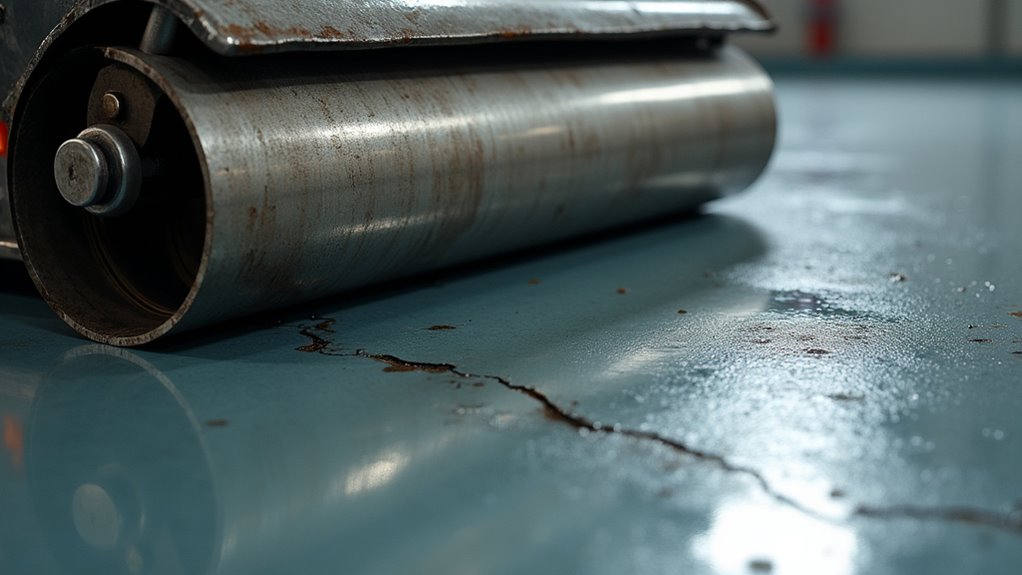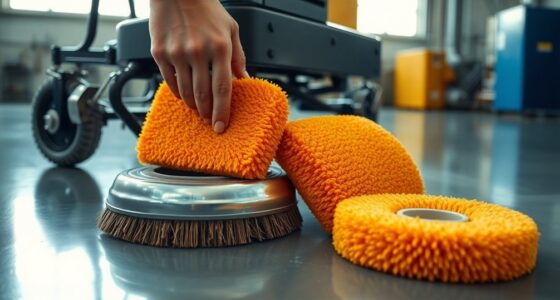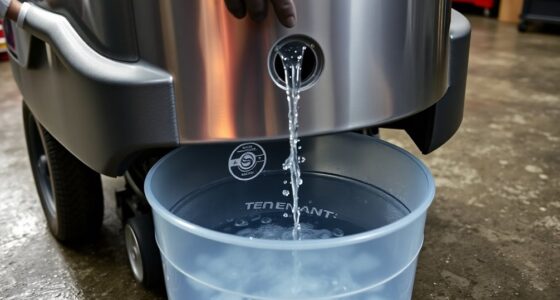Excessive downward pressure on epoxy floors can cause cracking, chipping, or delamination, risking damage and reducing durability. Generally, standard epoxy coatings support light to moderate foot traffic and equipment, but heavy machinery or stacked pallets can exceed their load limits. To prevent issues, avoid placing heavy objects without proper support and consider reinforcement if needed. Continuing further will help you understand more about maintaining your epoxy flooring’s strength and longevity.
Key Takeaways
- Excessive downward pressure can cause cracking, chipping, or delamination of epoxy coatings.
- The load limit depends on epoxy thickness, substrate strength, and surface preparation.
- Heavy machinery or stacked pallets may exceed the floor’s weight capacity, risking damage.
- Regular inspections can detect early signs of stress or surface damage from overloading.
- Supporting heavy loads with reinforcement or proper support measures prevents epoxy failure.

Epoxy floors are durable surfaces, but they can still be damaged if subjected to excessive down pressure. This means that understanding the limits of your epoxy surface’s durability is vital to maintaining its integrity over time. Epoxy surface durability depends on several factors, including the quality of the materials used, the surface preparation, and how much weight the flooring can safely support. While epoxy coatings are known for their toughness, they aren’t invincible. Pushing beyond the recommended flooring weight limits can lead to cracking, chipping, or even delamination of the epoxy layer.
Epoxy floors are tough but can crack under excessive weight.
When considering the weight your epoxy floor can handle, it’s important to be aware of its flooring weight limits. These limits aren’t just arbitrary numbers—they’re based on the thickness of the epoxy layer, the substrate it’s applied to, and the type of load. For example, a standard epoxy coating might support light to moderate foot traffic and equipment, but heavy machinery or stacked pallets can impose down pressures that exceed its capacity. If you’re unsure about the maximum weight your epoxy floor can handle, consult with the manufacturer or a flooring specialist. Ignoring these limits can lead to costly repairs and downtime.
To protect your epoxy surface’s durability, avoid placing exceptionally heavy objects directly on the floor without proper support. When moving heavy equipment, use ramps or dollies to distribute the weight more evenly. Reinforcing the floor with additional layers of epoxy or embedding a concrete slab beneath can also increase its strength if your operations demand it. Remember, the epoxy coating is a protective layer, but it relies on the underlying surface to bear the majority of the load. Overloading can cause stress fractures that compromise the entire flooring system.
Regular inspections are key to spotting early signs of damage caused by excessive down pressure. Look for cracks, chips, or areas where the surface seems uneven or worn. Addressing these issues early can prevent more serious damage and extend the lifespan of your epoxy flooring. Understanding the importance of surface durability and proper load management is essential for long-term performance. Ultimately, respecting the epoxy surface’s durability and flooring weight limits is essential for long-term performance. By understanding what your floor can handle and taking proactive steps to avoid overloading, you’ll ensure it remains a durable, reliable surface for years to come.
Frequently Asked Questions
How Does Temperature Affect Down Pressure on Epoxy Floors?
Temperature effects directly influence the down pressure on epoxy floors by impacting the curing process. When temperatures are too high, the epoxy may cure too quickly, causing it to become brittle and less resistant to pressure. Conversely, low temperatures slow curing, leading to inadequate bonding and possible delamination. Maintaining ideal temperature ensures proper curing, which helps your epoxy floor withstand the right amount of down pressure without damage or compromise.
Can Excessive Down Pressure Cause Epoxy Floor Delamination?
Excessive down pressure can cause epoxy floor delamination if it surpasses the pressure limits designed for proper epoxy adhesion. When you apply too much force, it can create air pockets or weak spots, compromising the bond between the epoxy and substrate. To avoid delamination, make certain your pressure stays within recommended levels, maintaining ideal epoxy adhesion and ensuring a durable, long-lasting surface. Always follow manufacturer guidelines for pressure applications.
What Tools Are Best for Measuring Down Pressure Accurately?
You should use pressure gauges and load cells to measure down pressure accurately. Pressure gauges provide real-time readings of force applied, helping you monitor pressure levels during installation. Load cells, on the other hand, measure the actual force exerted on the surface with high precision. Combining these tools ensures you can maintain ideal pressure, preventing damage like delamination and ensuring your epoxy floors cure properly.
Are Certain Epoxy Formulations More Resistant to High Down Pressure?
Think of epoxy formulation as armor for a castle—some are crafted stronger for high-pressure battles. Certain epoxy formulations are indeed more resistant to high down pressure, making them ideal for heavy-duty environments. When selecting, look for formulations designed for pressure resistance, ensuring your floor withstands the weight without cracking. You’ll want to choose those specifically engineered to handle the stresses, much like armor built for the toughest sieges.
How Often Should Down Pressure Be Monitored During Installation?
You should monitor down pressure regularly during installation to guarantee pressure consistency. Check it at least every 30 minutes or whenever the epoxy mix is stirred or surface conditions change. Following installation guidelines helps maintain proper pressure levels, preventing issues like uneven curing or air bubbles. Consistent monitoring ensures your epoxy floor bonds correctly, avoiding damage or failures caused by excessive or uneven pressure.
Conclusion
Pushing down too hard on your epoxy floor might seem harmless, but it could lead to unseen damage over time. Are you truly aware of the limits? Sometimes, what feels like nothing can quietly weaken the surface, risking long-term durability. Before you press harder, consider the hidden consequences. Remember, a little caution now could save you from unexpected repairs later. So, how much pressure is too much? The answer might surprise you.









